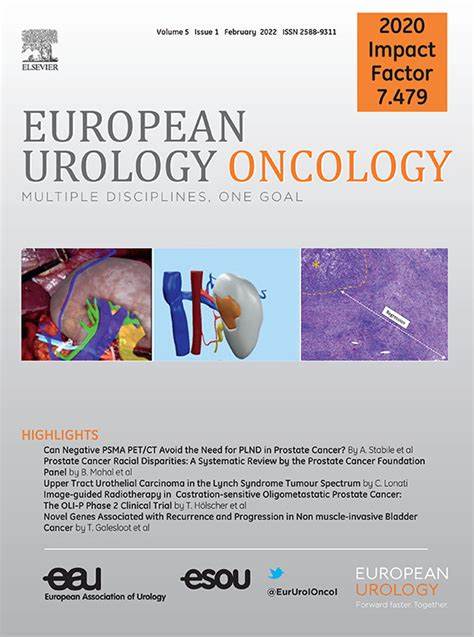Transcriptomic Analysis of Localized High-risk Prostate Cancer Improves Prognostication and Identifies Benefit from Adding Docetaxel to Definitive Radiotherapy with Androgen Suppression in the NRG Oncology/RTOG 0521 Phase 3 Trial
IF 9.3
1区 医学
Q1 ONCOLOGY
引用次数: 0
Abstract
Background and objective
NRG/RTOG 0521 randomized men with high-risk localized prostate cancer (PC) to androgen suppression (AS) and definitive radiotherapy (RT) ± docetaxel-based chemotherapy (CT). The overall survival (OS) benefit with CT initially reported was lost on longer follow-up. The Decipher genomic classifier (GC) measures multiple transcripts relevant to docetaxel action. Basal/luminal differentiation portends differential response to AS and CT for high-risk localized and metastatic hormone-sensitive PC. We validated the Decipher GC in pretreatment biopsy samples for risk stratification and examined basal-luminal subtyping to predict docetaxel response.
Methods
Decipher GC scores and basal-luminal cellular subtypes were generated for specimens from NRG/RTOG 0521. The primary objective was to validate the independent prognostic ability of GC for metastasis-free survival (MFS). Treatment effects in luminal proliferating (LP) and non-LP cell subtypes were examined in relation to MFS, OS, and distant metastasis (DM).
Key findings and limitations
Samples were obtained from 283 patients and yielded 183 GC scores. Over median follow-up of 9.9 yr, 67 metastasis events were observed, including 34 DM events. Multivariable analysis revealed that GC was independently associated with DM (subdistribution hazard ratio 1.45) and MFS (hazard ratio 1.20). No biomarker-by-treatment interaction with GC and docetaxel was detected. The 10-yr restricted mean survival time difference in OS with CT was 13.7 mo for LP (p = 0.053) and 2.5 mo for non-LP (p = 0.63) tumors.
Conclusions and clinical implications
The Decipher GC score was independently associated with DM and MFS, and LP tumors may benefit from addition of CT. Validation of these findings may allow more effective use of CT in men with localized PC.
The original NRG/RTOG 0521 trial is registered on ClinicalTrials.gov as NCT00288080.
NRG Oncology/RTOG 0521 3期试验中,局部高危前列腺癌的转录组学分析改善了预后,并确定了在雄激素抑制的最终放疗中添加多西他赛的益处。
背景与目的:NRG/RTOG 0521将高风险局限性前列腺癌(PC)患者随机分为雄激素抑制(AS)和最终放疗(RT)±多西他赛化疗(CT)两组。最初报道的CT的总生存(OS)益处在更长的随访中消失了。破译基因组分类器(GC)测量与多西他赛作用相关的多个转录本。基础/腔内分化预示着高风险的局部和转移性激素敏感性PC对AS和CT的不同反应。我们在预处理活检样本中验证了破译GC的风险分层,并检查了基底腔分型来预测多西他赛的反应。方法:对NRG/RTOG 0521样品进行解码GC评分和基底腔细胞亚型的生成。主要目的是验证GC对无转移生存(MFS)的独立预后能力。研究了对管腔增殖(LP)和非LP细胞亚型的治疗效果与MFS、OS和远处转移(DM)的关系。主要发现和局限性:从283例患者中获得样本,得到183个GC评分。中位随访9.9年,观察到67例转移事件,包括34例糖尿病事件。多变量分析显示,GC与DM(亚分布风险比1.45)和MFS(风险比1.20)独立相关。未检测到与GC和多西紫杉醇的生物标志物相互作用。10年OS与CT的限制平均生存时间差异,LP肿瘤为13.7个月(p = 0.053),非LP肿瘤为2.5个月(p = 0.63)。结论和临床意义:破译GC评分与DM和MFS独立相关,LP肿瘤可能受益于CT的增加。这些发现的验证可能允许更有效地使用CT诊断局限性PC。最初的NRG/RTOG 0521试验在ClinicalTrials.gov上注册为NCT00288080。
本文章由计算机程序翻译,如有差异,请以英文原文为准。
求助全文
约1分钟内获得全文
求助全文
来源期刊

European urology oncology
Multiple-
CiteScore
15.50
自引率
2.40%
发文量
128
审稿时长
20 days
期刊介绍:
Journal Name: European Urology Oncology
Affiliation: Official Journal of the European Association of Urology
Focus:
First official publication of the EAU fully devoted to the study of genitourinary malignancies
Aims to deliver high-quality research
Content:
Includes original articles, opinion piece editorials, and invited reviews
Covers clinical, basic, and translational research
Publication Frequency: Six times a year in electronic format
 求助内容:
求助内容: 应助结果提醒方式:
应助结果提醒方式:


